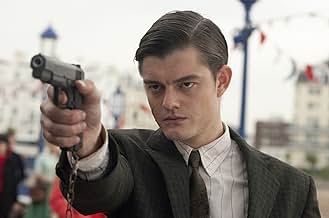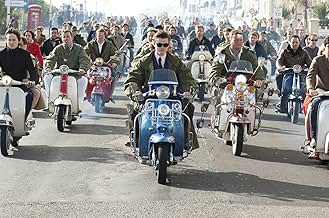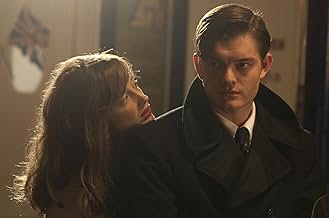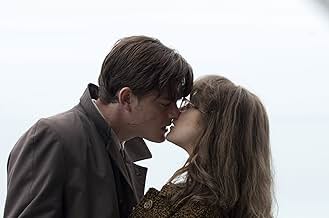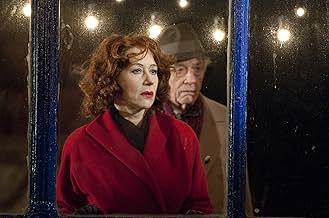NOTE IMDb
5,7/10
6,9 k
MA NOTE
Ajouter une intrigue dans votre langueCharts the headlong fall of Pinkie, a razor-wielding disadvantaged teenager with a religious death wish.Charts the headlong fall of Pinkie, a razor-wielding disadvantaged teenager with a religious death wish.Charts the headlong fall of Pinkie, a razor-wielding disadvantaged teenager with a religious death wish.
- Réalisation
- Scénario
- Casting principal
- Récompenses
- 1 victoire et 8 nominations au total
Phil Davis
- Spicer
- (as Philip Davis)
Avis à la une
7rbrb
This is a dark,intense 'film noir' type drama.
The backdrop to it is Brighton, England of the 1960's with rebelling youth(mods and rockers).The actual story is about a young murderous psychopath thug involved in a gang war. A gullible waitress unwittingly becomes a witness to murder and the thug needs to deal with it.
The movie is atmospheric and grim. No hint of much happiness nor any likable characters.Everyone in the movie is flawed in one way or another. Maybe that is why many people did not rate this movie highly.
There is a religious and moral agenda in this picture which if recognized may disturb some viewers.
I thought all the main actors gave edgy and compelling performances. The 2 leads namely Sam Riley and Andrea Riseborough are outstanding with on balance the latter stealing the show.
The very last scene in the film is brilliant and thought provoking.
7/10
The backdrop to it is Brighton, England of the 1960's with rebelling youth(mods and rockers).The actual story is about a young murderous psychopath thug involved in a gang war. A gullible waitress unwittingly becomes a witness to murder and the thug needs to deal with it.
The movie is atmospheric and grim. No hint of much happiness nor any likable characters.Everyone in the movie is flawed in one way or another. Maybe that is why many people did not rate this movie highly.
There is a religious and moral agenda in this picture which if recognized may disturb some viewers.
I thought all the main actors gave edgy and compelling performances. The 2 leads namely Sam Riley and Andrea Riseborough are outstanding with on balance the latter stealing the show.
The very last scene in the film is brilliant and thought provoking.
7/10
A really big step in the career of Richard Attenborough came when he starred in the first film of Graham Greene's novel Brighton Rock. It was so good you'd think no one would try and top it, but in 2010 the story was filmed again and the time of the story updated from post war Great Britain to the swinging sixties and the riots between the Mod and Rocker teens. That is the background for young Sam Riley to try and take a really big step in the rackets.
Which are pretty much the same as they are here although it is rare that guns are used as per the culture. Sam Riley in the lead role that helped give a boost to Richard Attenborough's career is an amoral young man who gets involved in a homicide. A revenge killing really, but a young woman who works in Helen Mirren's store can finger him for the crime.
What to do but woo Andrea Riseborough and marry her so she can't testify against him. But when Riley's crew leans on Mirren's friend John Hurt at his place of business and the guy that Riley killed was Mirren's boyfriend she'll do what it takes to take Riley down.
Some nice shots of Brighton which is like Atlantic City here, a rather run down resort area, or at least Atlantic City was before the casinos arrived. Riley, Riseborough, Mirren, and Hurt do quite well by their roles.
There is a really nice performance by Andy Serkis as a rather flamboyant gay gangster who is head of the other mob. He checks out Riley like a slab of beef on the rack at the butcher shop, but he doesn't let his lust get in the way of squelching a rival.
There's also a little more of the Catholicism of Graham Greene in the plot than there was in the first film. Even as amoral a young man as Riley does get guilt tripped quite a bit for the advantage he takes of Riseborough.
Not a bad film, but not up to what Richard Attenborough starred in.
Which are pretty much the same as they are here although it is rare that guns are used as per the culture. Sam Riley in the lead role that helped give a boost to Richard Attenborough's career is an amoral young man who gets involved in a homicide. A revenge killing really, but a young woman who works in Helen Mirren's store can finger him for the crime.
What to do but woo Andrea Riseborough and marry her so she can't testify against him. But when Riley's crew leans on Mirren's friend John Hurt at his place of business and the guy that Riley killed was Mirren's boyfriend she'll do what it takes to take Riley down.
Some nice shots of Brighton which is like Atlantic City here, a rather run down resort area, or at least Atlantic City was before the casinos arrived. Riley, Riseborough, Mirren, and Hurt do quite well by their roles.
There is a really nice performance by Andy Serkis as a rather flamboyant gay gangster who is head of the other mob. He checks out Riley like a slab of beef on the rack at the butcher shop, but he doesn't let his lust get in the way of squelching a rival.
There's also a little more of the Catholicism of Graham Greene in the plot than there was in the first film. Even as amoral a young man as Riley does get guilt tripped quite a bit for the advantage he takes of Riseborough.
Not a bad film, but not up to what Richard Attenborough starred in.
One of the perils of remaking a classic film is that your version will be compared unfavourably with the original. Of course, there have always been film-makers who have dared to brave this peril, and it is as well that there have been, otherwise we would have been deprived of, for example, Kenneth Branagh's interpretation of "Henry V", which spoke to the eighties just as Laurence Olivier's had spoken to the forties.
Graham Greene's novel "Brighton Rock" was famously adapted for the screen by the Boulting brothers in 1947, and their version is widely regarded as one of the greatest films from the "Golden Age" of the British cinema during the forties and fifties. Rowan Joffé's recent remake has not been universally well-received, particularly by those who believe that nothing can ever compete with its illustrious predecessor. Much as I admire the Boultings' film, however, I have to admit that the newcomer has many virtues of its own.
The main character is Pinkie Brown, the youthful leader of a gang of thugs whose principal activity is protection racketeering. Early in the film, Pinkie murders Hale, a member of a rival gang, in revenge for the murder by Hale of Pinkie's colleague Kite. (In the original novel and the 1947 film, Hale was a journalist who had been investigating the gang's activities. Another change is the date at which the story takes place; although the novel and original film are both set in the 1930s, this adaptation is set during the Mods and Rockers era of the 1960s).
Pinkie tries to cover his tracks by creating a false alibi for himself, which leads to the commission of further crimes and to Pinkie's marriage to Rose, a young waitress who he believes might be in possession of evidence which could send him to the gallows. Pinkie is not in love with Rose, but marries her because at the time the film is set there was a rule of English law that a wife could not give evidence against her husband. The ending is closer to the one Greene wrote in his novel, although Joffé keeps the famous twist which the writer introduced when he produced the 1947 screenplay.
Joffe said that he made the film because, on reading the novel, he "fell absolutely in love with the character of Rose", and the treatment of this character is, in my view, the one area in which the modern film is better than the earlier one. Andrea Riseborough's interpretation of the character- downbeat, dowdy, bespectacled and needy- seems just right for the role. Rose responds to Pinkie's overtures because he is the only person to have shown her any affection, and she is naïve enough to overlook his obvious criminality and not to realise that his affection for her is feigned. Carol Marsh's Rose, however, was rather too glamorous; it was difficult to imagine her as someone lacking in male admirers.
There are also good performances from two veterans of the British cinema, John Hurt and Helen Mirren. Hurt plays the bookmaker Phil Corkery, who has a more important role in this adaptation than he does in the book. Mirren plays Ida Arnold, the woman whose determination to get at the truth results in Pinkie's downfall. In the 1947 Ida was played by Hermione Baddeley as a blowsy, ageing showgirl and a casual acquaintance of Hale; here she becomes the manageress of the café where Rose works and a close friend of the murdered man.
I was less impressed by Sam Riley who, as Pinkie, lacked the sense of menace and evil which Richard Attenborough brought to the role. At 30, moreover, Riley seemed too old to play a teenager. (Attenborough would have been 24 in 1947, and looked younger). Also, I couldn't see the point of setting the story in the 1960s, as the "Mods and Rockers" element added little, or nothing, to Greene's story. Pinkie's gang, and the rival Colleoni gang, were both part of Brighton's own criminal underworld, whereas the Mods and Rockers were drawn from all over the country, especially London, and merely chose Brighton, and other seaside resorts, as convenient places for their battles.
Joffé has also discarded a lot of the religious content of the original novel. Greene made Ida an atheist whose system of values was based upon secular ideas of "right" and "wrong", as opposed to Pinkie and Rose, both believing Catholics who believed firmly in "good" and "evil". This opposition between two contrasting attitudes to morality was an important theme of the novel, but it is not something dwelt on at length in either film. The 1947 version downplayed Pinkie's religious beliefs, possibly as a concession to Catholics unhappy with the idea of one of their flock being portrayed as a violent criminal, although it did concentrate on Rose's spiritual development. The modern film acknowledges that both Pinkie and Rose are "Romans", but for the most part avoids theological issues and turns Greene's story into the basis for a grim, grey neo-noir type crime thriller. (The 1947 film was set during a sunny summer Bank Holiday; this version appears to have been shot in winter, with Brighton largely deserted by holidaymakers). It is up to the viewer to decide which approach he or she prefers. 7/10
Graham Greene's novel "Brighton Rock" was famously adapted for the screen by the Boulting brothers in 1947, and their version is widely regarded as one of the greatest films from the "Golden Age" of the British cinema during the forties and fifties. Rowan Joffé's recent remake has not been universally well-received, particularly by those who believe that nothing can ever compete with its illustrious predecessor. Much as I admire the Boultings' film, however, I have to admit that the newcomer has many virtues of its own.
The main character is Pinkie Brown, the youthful leader of a gang of thugs whose principal activity is protection racketeering. Early in the film, Pinkie murders Hale, a member of a rival gang, in revenge for the murder by Hale of Pinkie's colleague Kite. (In the original novel and the 1947 film, Hale was a journalist who had been investigating the gang's activities. Another change is the date at which the story takes place; although the novel and original film are both set in the 1930s, this adaptation is set during the Mods and Rockers era of the 1960s).
Pinkie tries to cover his tracks by creating a false alibi for himself, which leads to the commission of further crimes and to Pinkie's marriage to Rose, a young waitress who he believes might be in possession of evidence which could send him to the gallows. Pinkie is not in love with Rose, but marries her because at the time the film is set there was a rule of English law that a wife could not give evidence against her husband. The ending is closer to the one Greene wrote in his novel, although Joffé keeps the famous twist which the writer introduced when he produced the 1947 screenplay.
Joffe said that he made the film because, on reading the novel, he "fell absolutely in love with the character of Rose", and the treatment of this character is, in my view, the one area in which the modern film is better than the earlier one. Andrea Riseborough's interpretation of the character- downbeat, dowdy, bespectacled and needy- seems just right for the role. Rose responds to Pinkie's overtures because he is the only person to have shown her any affection, and she is naïve enough to overlook his obvious criminality and not to realise that his affection for her is feigned. Carol Marsh's Rose, however, was rather too glamorous; it was difficult to imagine her as someone lacking in male admirers.
There are also good performances from two veterans of the British cinema, John Hurt and Helen Mirren. Hurt plays the bookmaker Phil Corkery, who has a more important role in this adaptation than he does in the book. Mirren plays Ida Arnold, the woman whose determination to get at the truth results in Pinkie's downfall. In the 1947 Ida was played by Hermione Baddeley as a blowsy, ageing showgirl and a casual acquaintance of Hale; here she becomes the manageress of the café where Rose works and a close friend of the murdered man.
I was less impressed by Sam Riley who, as Pinkie, lacked the sense of menace and evil which Richard Attenborough brought to the role. At 30, moreover, Riley seemed too old to play a teenager. (Attenborough would have been 24 in 1947, and looked younger). Also, I couldn't see the point of setting the story in the 1960s, as the "Mods and Rockers" element added little, or nothing, to Greene's story. Pinkie's gang, and the rival Colleoni gang, were both part of Brighton's own criminal underworld, whereas the Mods and Rockers were drawn from all over the country, especially London, and merely chose Brighton, and other seaside resorts, as convenient places for their battles.
Joffé has also discarded a lot of the religious content of the original novel. Greene made Ida an atheist whose system of values was based upon secular ideas of "right" and "wrong", as opposed to Pinkie and Rose, both believing Catholics who believed firmly in "good" and "evil". This opposition between two contrasting attitudes to morality was an important theme of the novel, but it is not something dwelt on at length in either film. The 1947 version downplayed Pinkie's religious beliefs, possibly as a concession to Catholics unhappy with the idea of one of their flock being portrayed as a violent criminal, although it did concentrate on Rose's spiritual development. The modern film acknowledges that both Pinkie and Rose are "Romans", but for the most part avoids theological issues and turns Greene's story into the basis for a grim, grey neo-noir type crime thriller. (The 1947 film was set during a sunny summer Bank Holiday; this version appears to have been shot in winter, with Brighton largely deserted by holidaymakers). It is up to the viewer to decide which approach he or she prefers. 7/10
Hearing the news that John Boulting's classic 1946 adaptation of Graham Greene's novel Brighton Rock was to be remade filled with me trepidation. The current spate of mostly inferior remakes are one thing but meddling with the perfection of this archetypical gangster film is another. How can any updated version possibly replace the indelible image of the 23 year old Richard Attenborough as the flick knife wielding baby faced assassin Pinkie Brown? As filming began and rumours of a 1960s Mods and Rockers setting emerged I began to have serious doubts if this remake was really going to be a good idea! Thankfully fears that Rowan Joffe's Brighton Rock is a sanitised version of the story are quickly allayed. The relocation of Brighton Rock to the 1960s does not mean that we are entering into the trendy youth culture of the era or being taken on an adolescent search for identity. The sharp-suited posers and greasy leather clad Rockers are merely a backdrop to a much darker reality as we are taken into a terrifying world of crime, guilt and inner-torment.
Brighton Rock is concerned with the concepts of good versus evil, sin and redemption they were present in Greene's novel, the 1946 adaptation and once again are central in Rowan Joffe's remake. However, additional scenes and alterations to the 2010 update mean that Pinkie's progressively violent behaviour is almost justified. In the exhilarating opening sequence Pinkie witnesses the brutal murder of the gang's original leader Kite when Fred Hale slashes his throat. When Pinkie sees one of the few role models in his life burbling and drowning in his own blood revenge it seems is not only on the cards but unavoidable. This kind of black and white, eye for an eye, morality detracts from the original story where Pinkie Brown's vicious streak appeared to be innate and a product of original sin. The character of Ida Arnold (Dame Helen Mirren) also has undergone a significant adjustment. In opposition to the Catholicism of Pinkie and Rose the pleasure seeking Ida was concerned only with the here and now. Mirren's portrayal plays these aspects down resulting in a more serious role and a lessening of the story's theological study.
As with Attenborough before him Sam Riley's Pinkie is intense, dangerous and teeters on the edge of sanity. If anything in Joffe's adaptation Pinkie Brown undergoes a broader transformation than before as greater emphasis being placed upon his journey from a nervous lackey to maniacal gang leader. Unfortunately the 30 year old Riley he does not resemble a juvenile delinquent. Therefore the shy adolescent awkwardness that Pinkie displays towards adulthood and in particular his relationship with Rose, (conveyed so expertly by Attenborough,) is absent.
Andrea Riseborough gives an outstanding performance as Rose she too goes on a psychological journey from being a naive and mousey youngster to an assertive young woman attracted to Pinkie's confidence and menace. The scene in which Pinkie in effect buys Rose from her abusive father for £150 adds a social realist dimension to the film uncovering the lack of options available to a young working-class woman in 'sixties Britain. The squalid surroundings of Pinkie and Rose's flat complete with peeling wallpaper, scuffed furniture and squeaky floorboards are also reminiscent of a Kitchen Sink drama. There is some impressive cinematography by John Mathieson as the camera pans from the threatening crashing waves on Brighton Beach to the scenic seaside cafés foreshadowing the storm that is building. The swelling orchestral soundtrack also adds to the heightened sense of panic and drama. The tea rooms, arcades and dance-halls of 1960s Brighton are also accurately recreated as are the neglected interiors of the boarding houses. And yet There is something oddly unreal about Joffe's Brighton Rock partly down to the unnecessary time shift which does nothing but confuse the audience. The film's characters seem stuck in the wrong era originating as they do from austere post-war Britain both in appearance and behaviour. Using the Mods and Rockers backdrop and casting of Philip Davis, (who appeared in Quadrophenia,) as Spicer turns the movie into a pastiche of sorts leaving us with a souped-up hyper-reality. This is Brighton as seen through the eyes of the cinema goer not the world of Graham Greene's novel. Dark, menacing and suspenseful Rowan Joffe's Brighton Rock is well worth seeing it is just unfortunate that the film is not as good as the sum of its parts.
Brighton Rock is concerned with the concepts of good versus evil, sin and redemption they were present in Greene's novel, the 1946 adaptation and once again are central in Rowan Joffe's remake. However, additional scenes and alterations to the 2010 update mean that Pinkie's progressively violent behaviour is almost justified. In the exhilarating opening sequence Pinkie witnesses the brutal murder of the gang's original leader Kite when Fred Hale slashes his throat. When Pinkie sees one of the few role models in his life burbling and drowning in his own blood revenge it seems is not only on the cards but unavoidable. This kind of black and white, eye for an eye, morality detracts from the original story where Pinkie Brown's vicious streak appeared to be innate and a product of original sin. The character of Ida Arnold (Dame Helen Mirren) also has undergone a significant adjustment. In opposition to the Catholicism of Pinkie and Rose the pleasure seeking Ida was concerned only with the here and now. Mirren's portrayal plays these aspects down resulting in a more serious role and a lessening of the story's theological study.
As with Attenborough before him Sam Riley's Pinkie is intense, dangerous and teeters on the edge of sanity. If anything in Joffe's adaptation Pinkie Brown undergoes a broader transformation than before as greater emphasis being placed upon his journey from a nervous lackey to maniacal gang leader. Unfortunately the 30 year old Riley he does not resemble a juvenile delinquent. Therefore the shy adolescent awkwardness that Pinkie displays towards adulthood and in particular his relationship with Rose, (conveyed so expertly by Attenborough,) is absent.
Andrea Riseborough gives an outstanding performance as Rose she too goes on a psychological journey from being a naive and mousey youngster to an assertive young woman attracted to Pinkie's confidence and menace. The scene in which Pinkie in effect buys Rose from her abusive father for £150 adds a social realist dimension to the film uncovering the lack of options available to a young working-class woman in 'sixties Britain. The squalid surroundings of Pinkie and Rose's flat complete with peeling wallpaper, scuffed furniture and squeaky floorboards are also reminiscent of a Kitchen Sink drama. There is some impressive cinematography by John Mathieson as the camera pans from the threatening crashing waves on Brighton Beach to the scenic seaside cafés foreshadowing the storm that is building. The swelling orchestral soundtrack also adds to the heightened sense of panic and drama. The tea rooms, arcades and dance-halls of 1960s Brighton are also accurately recreated as are the neglected interiors of the boarding houses. And yet There is something oddly unreal about Joffe's Brighton Rock partly down to the unnecessary time shift which does nothing but confuse the audience. The film's characters seem stuck in the wrong era originating as they do from austere post-war Britain both in appearance and behaviour. Using the Mods and Rockers backdrop and casting of Philip Davis, (who appeared in Quadrophenia,) as Spicer turns the movie into a pastiche of sorts leaving us with a souped-up hyper-reality. This is Brighton as seen through the eyes of the cinema goer not the world of Graham Greene's novel. Dark, menacing and suspenseful Rowan Joffe's Brighton Rock is well worth seeing it is just unfortunate that the film is not as good as the sum of its parts.
I decided to watch Brighton Rock after I had heard good things about it and I thought it would be interesting to watch. It seemed different to other films and in a genre of it's own. It was not a bad film but at the same time it wasn't the best,I would say stick to the novel and original. The start was very slow. Helen Mirren and Sam Riley gave amazing performances and owned the film, while Andrea Riseborough gave a great performance as the annoying and needy Rose. The performances and cast make up for the lack of excitement. There are a few twist within and some action scenes that make the film that bit more interesting. It's a rememberable film but I wouldn't plan on watching it again.
Le saviez-vous
- AnecdotesPhil Davis (Frank Spicer) previously played the mod Chalky in Quadrophenia (1979), which was likewise set in Brighton in 1964.
- GaffesWhen Rose opens the record player, it has a modern British plug on it. In 1960s Britain plug pins were round. Safety switches wall sockets would not have been in place at this time, either.
- ConnexionsFeatured in Breakfast: Épisode datant du 28 janvier 2011 (2011)
Meilleurs choix
Connectez-vous pour évaluer et suivre la liste de favoris afin de recevoir des recommandations personnalisées
- How long is Brighton Rock?Alimenté par Alexa
Détails
- Date de sortie
- Pays d’origine
- Site officiel
- Langue
- Aussi connu sous le nom de
- Băng Đảng Brighton
- Lieux de tournage
- Sociétés de production
- Voir plus de crédits d'entreprise sur IMDbPro
Box-office
- Budget
- 12 000 000 $US (estimé)
- Montant brut aux États-Unis et au Canada
- 229 653 $US
- Week-end de sortie aux États-Unis et au Canada
- 32 774 $US
- 28 août 2011
- Montant brut mondial
- 2 913 599 $US
- Durée
- 1h 51min(111 min)
- Couleur
- Mixage
- Rapport de forme
- 2.39 : 1
Contribuer à cette page
Suggérer une modification ou ajouter du contenu manquant





